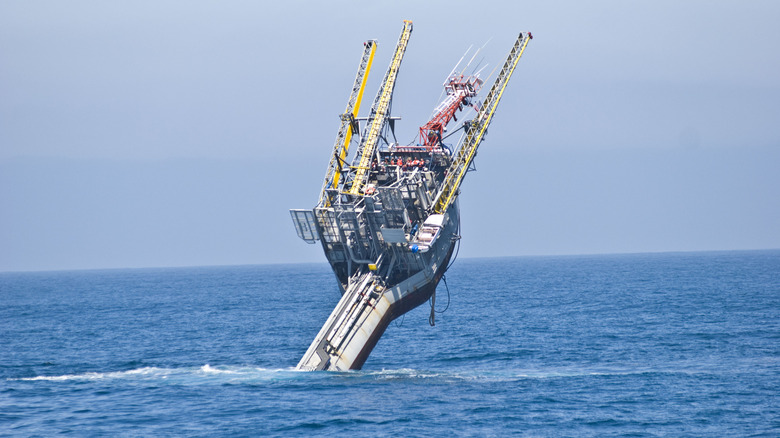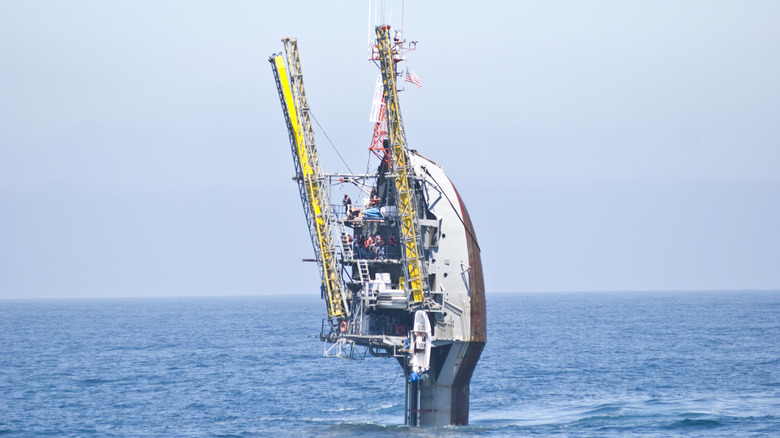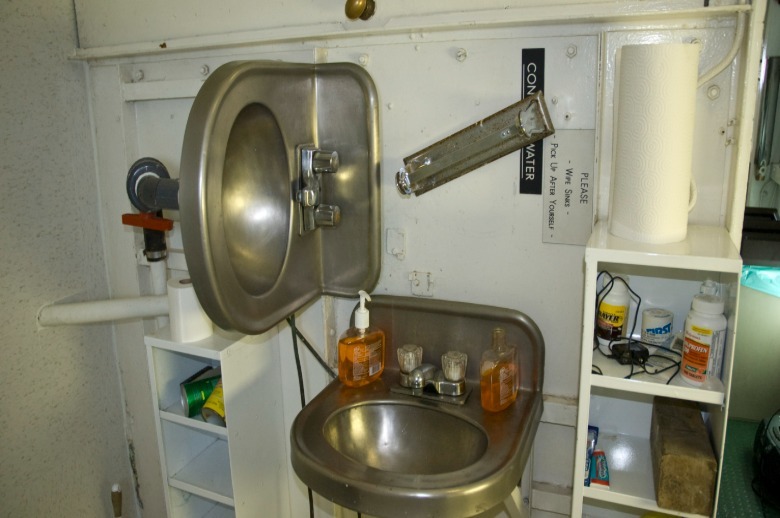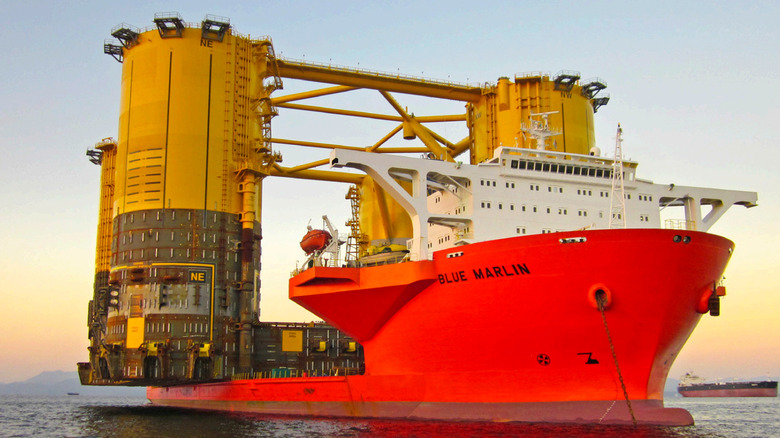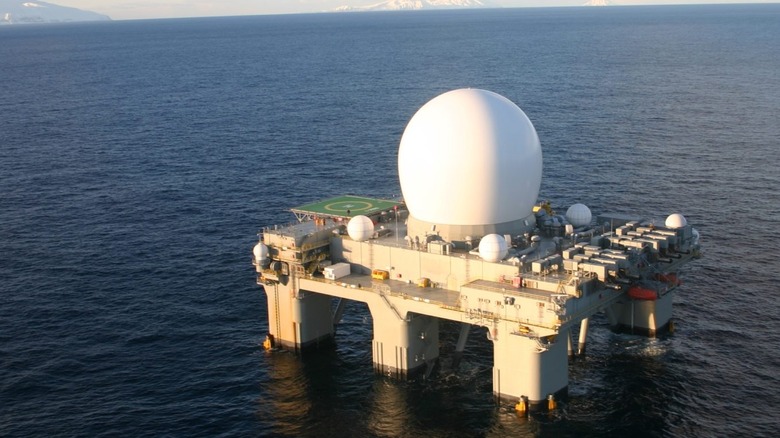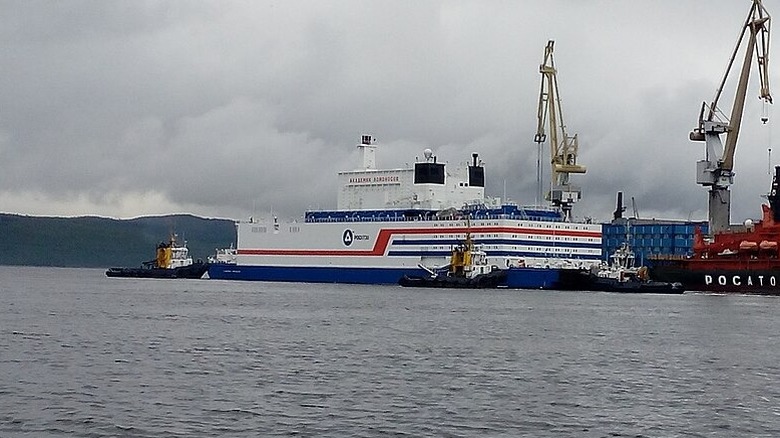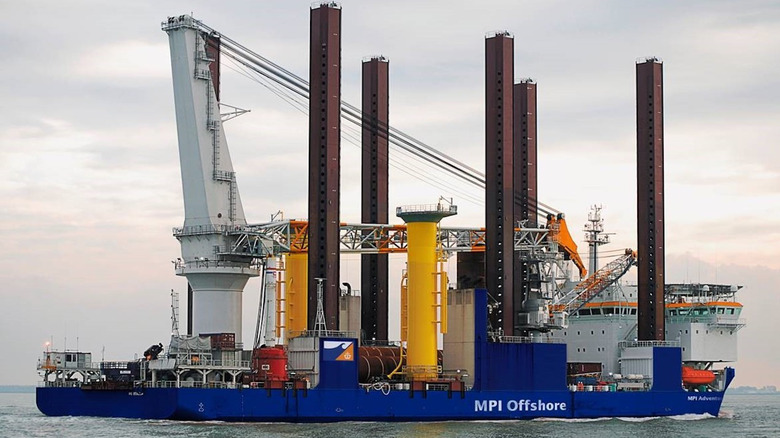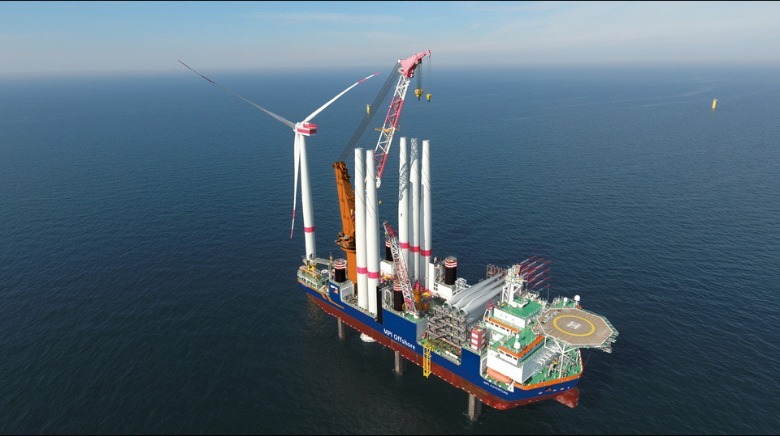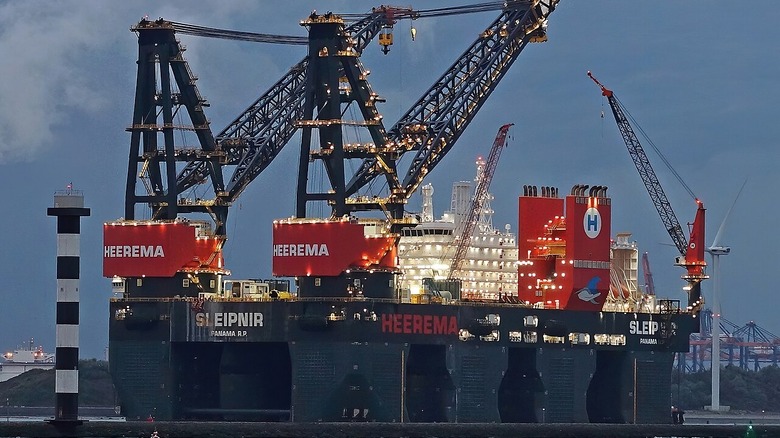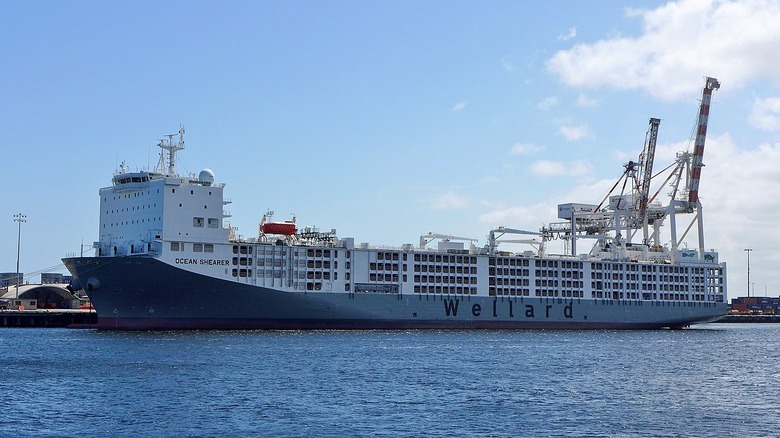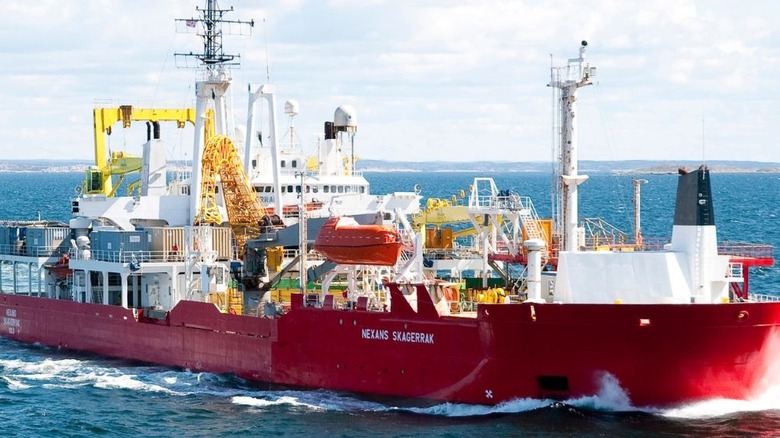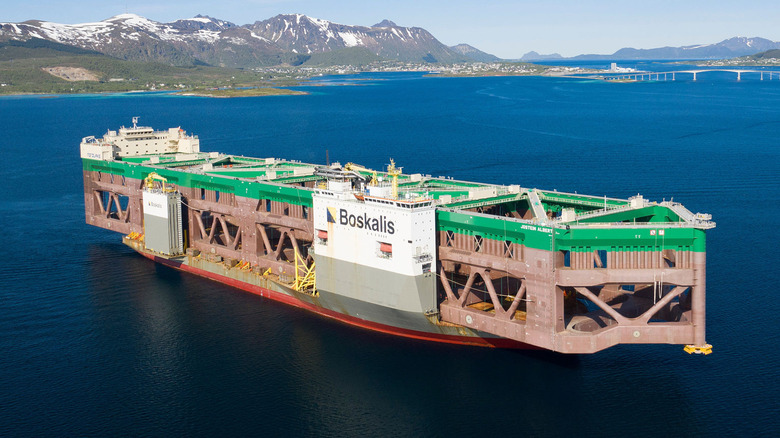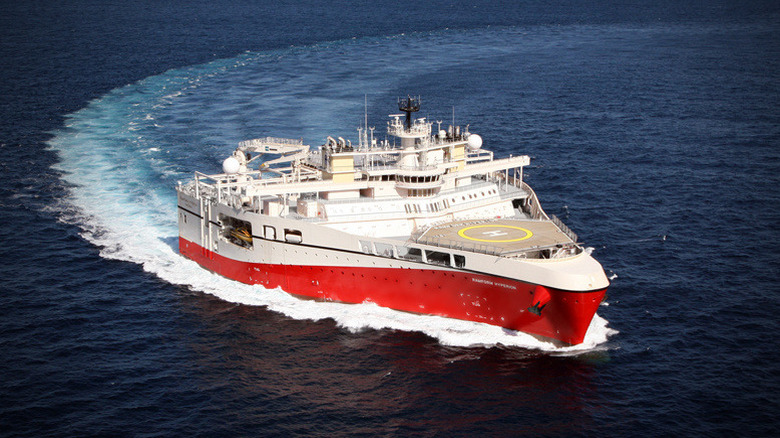10 Super-Specialized Ships You Might Not Know Existed
Ships are the backbone of the global economy, ferrying goods and people across the most inhospitable place on earth — the ocean. Our planet is 70-ish percent water, which means that, theoretically, to get to or across most of our planet, we need water-going vehicles. And indeed, ships have been around for centuries, with most historians agreeing that the Vikings made the first transatlantic crossing around the 10th century. Since then, ships have evolved to take on more and more specific roles — some are cruise ships with massive fuel tanks to shuttle holidaymakers about, some transport cargo, some are luxury superyachts, and still others have a mix of missions. All of this is pretty standard stuff, and we've gotten used to it.
However, there are many ships on our oceans today that are not what we would call regular. These ships have special purposes, payloads, or abilities that set them apart from so-called normal vessels. Here are 12 of the most highly specialized ships on our oceans today.
Before we begin, no, the ship in the cover image is not sinking.
RV FLIP
The first ship on our list comes from the University-National Oceanographic Laboratory System (UNOLS), which is a part of the U.S. research fleet specializing in ocean and climate data collection. There are 17 ships in the United States research fleet, but none so peculiar as the FLIP. The name — really, who gives U.S. Navy ships their names? — is a contraction of the words Floating Instrument Platform, and the ship's party piece is that it flips itself 90 degrees to stand vertically in the water. Yes, you read that right. This is a 355-foot-long ocean-going vessel that transforms from a ship into a buoy, and the main reason for doing so is to make the ship more stable.
To that end, the FLIP actually sends the vast majority of its length under the water. When at maximum depth, 300 out of 355 feet are under the waves. This lets the FLIP remain very stable even in rough, choppy seas, which in turn allows for far more accurate data collection. The stability also makes the FLIP safer in storms, when other marine vessels would have to return to calmer waters. FLIP had many quirks, as all equipment onboard had to work in both vertical and horizontal orientations, leading to some interesting design choices, like the sinks shown below.
Sadly, the FLIP, at 61 years old, was retired and sent for scrap in 2023. Yes, this oddity was launched in the same decade that we sent people to the moon.
Blue Marlin & Black Marlin
Next up, we have an identical sister ship duo, the Blue Marlin and Black Marlin, each of which is a heavy load carrier (HLC). In recent decades, the oil and gas industry has tended towards massive, offshore floating oil platforms. To get these platforms out to where they need to be (which can be hundreds of miles offshore in some cases), ships like these two HLCs are used. Built by the China Shipbuilding company, the twin ships are classified as special service semi-submersible heavy lift vessels, and are truly massive at 737.5 feet (224.80 meters) long and 206 feet (63 meters) wide. The way they operate is actually quite simple. The majority of the ship consists of a flat main deck that sits above the waterline, but it can be submerged.
Once the main deck is underwater, whatever needs to be transported, be it oil platforms, living quarters, or even other ships, is towed into place, and the main deck is refloated. As the main deck rises above the waterline, helped by four massive ballast pumps that can pump 3,300 cubic meters of water per hour, the cargo rises above the waterline as well. From that point on, it's just a game of getting to the end location, where the process happens in reverse.
Some notable things that have been transported on these ships include ConocoPhillips' DPP platform from Hyundai shipbuilding in Korea to the Timor Sea, the USS Cole from Yemen to the U.S., and the largest rig of its kind, ExxonMobil's Thunder Horse PDQ, from Daewoo shipbuilding in South Korea to Texas.
Sea-Based X-Band Radar
You know how sometimes ships have radar? Well, this radar is a ship. This oddity, co-produced by Boeing and Raytheon, is actually one of the most specialized radar stations on earth. That's literally the only function of the Sea-Based X-Band Radar, commonly shortened to SXB-1 — housing radars that can protect us from ballistic missile attacks that could be launched from submarines out at sea, for example. It is part of an early warning system that constantly scans the skies for evidence of an incoming missile attack, but given its military use, details of its operation are scarce. What we do know is that it is officially a part of the Ballistic Missile Defense System (BMDS) and falls under the purview of the Director, Operational Test & Evaluation (DOTE), who in turn reports directly to the Secretary of Defense.
The SXB-1 is mounted on top of a semi-submersible vessel and can house multiple bulbous radar units (called radomes), the largest of which weighs 18,000 pounds. Given that massive size, it's downright impressive that SXB-1 has a cruising speed of 8 knots, and can detect objects as small as a baseball from as far away as 2,500 miles. It displaces 32,690 tons, is 389 feet (119 meters) long, and houses a crew of 85, who operate with 60 days of supplies and rations. That kind of size moving at 8 knots really makes you wonder how the engines for these massive ships are made. The SXB-1 has been dedicated to detecting missile tests launched by the dictatorship of North Korea, and as such, has been stationed somewhere in the Pacific.
Akademik Lomonosov
Next up, we have an ocean-going nuclear power station that's capable of powering a small city. Granted, nuclear power has been used to propel ships for a long time now, but this is the first time that a nuclear vessel on the high seas has been solely dedicated to producing electricity. The ship is named the Akademik Lomonosov and was developed by the Russian Federation to serve the Arctic economic zone of Chukotka, some 3,400 miles from the country's capital, Moscow. It is, as of May 2025, the only floating nuclear power station in the world, and Russia plans to build three more just like it, with hopes of selling them to other countries in the future.
In 2025, the 70 megawatt-equivalent Akademik marks five years of active operation, and, at the time of writing, has produced more than 1 billion kilowatt hours (kWh) of electricity since the lights were first turned on. As of 2020, the Lomonosov has been tasked with providing electricity to a small northern port by the name of Pevek, which is in the aforementioned Chukotka region. An interesting calculation that has been made is that the Akademik Lomonos now produces enough electricity to make everyone on Earth a double espresso. There's a fun dinner table fact. Currently, the Lomonosov manages to meet 60% of the power demand of the Chukotka and neighboring Chersky region in Yakutia, which is quite impressive.
TIVs MPI Adventure and MPI Resolution
Here is another pair of sister ships, just like the Black and Blue Marlins from earlier, albeit with a very different mission. The MPI Adventure and MPI Resolution were designed and built from the ground up with one specific purpose in mind: to withstand any natural weather phenomenon in shallow waters. Both of them are Turbine Installation Vessels, hence the name, TIV. If you've ever wondered how windmills get all those many miles offshore, this is how. The ships' unique trait is the ability to stand on their own legs so that they can literally rise above the waves. Here, have a look:
Currently, they are more of a sea trial than permanent deployment, but for now, they house an offshore wind generator system, aiming to provide Europe with clean energy. Potentially, if they do well in this deployment, we could be seeing lots more of their class dotting Europe's coastlines. An additional functionality of both ships is that they can be used to lay the foundations for offshore wind turbines, so that permanent wind farms can be made a reality. Also, interestingly, the same company constructed and launched the world's first purpose-built wind turbine installation ship, the MPI Resolution, in 2003. After a massive commercial success, MPI commissioned and then launched the Resolution's sister ship, Adventure, in 2011.
SSCV Sleipnir
This thing (can we even call it a ship?) is like a semi-truck but for entire oil platforms. Just like the Blue and Black Marlin twin ships from earlier, you can load an oil platform onto the Sleipnir or have it tow the oil platform out to where it needs to be. It is powered by liquefied natural gas (LNG), which is actually a co-discovery in some places when extracting oil, which, all things considered, is rather poetic. Sleipnir is also considered to be a relatively green (sustainable) machine, at least as sustainable as anything in this industry can be. Heerema, the company that operates the Sleipnir, says that it can install rigs of up to 20,000 metric tons "doing it sustainably". This mind-bogglingly large lifting capacity — remember, this is on the high seas, not on land — comes courtesy of two cranes, each capable of lifting 11,000 tons.
Add to that the fact that Sleipnir can travel at a maximum speed of 10 knots, and you're left wondering if there will be anything that can top it. That top speed figure is even more impressive when considering Sleipnir's size: 722 feet (220 meters) long, 335 feet (102 meters) wide, with 105 feet (32 meters) under the waterline and space to accommodate 400 crew members. One of the landmark projects that Sleipnir has played a part in since launching in 2019 is removing the jacket (shell) of the Brent Alpha platform, which had been up since 1976.
Currently, Sleipnir's home port is Rotterdam, but who knows where Heerema will send it next?
MV Ocean Shearer and MV Ocean Drover
The MV Ocean Shearer, formerly Stella Deneb, was once the world's largest livestock carrier. Stella Deneb isn't the only former name for this behemoth. At different points in her lifespan, she's been called the Deneb Prima, Rodolfo Mata, Ming Universe, and Med Genova. The ship retired from service in 2012, but the former owners, Australian company Wellard, have since replaced it with another ship called the MV Ocean Drover.
The Ocean Shearer used to hold the record for transporting the most head of cattle, ever, at about 25,800 head in a single voyage in 2011. As far as we can tell, that record still stands. Now, the MV Ocean Shearer had been launched in 1980, making it pretty old by transport ship standards, and had also been through at least five major overhauls.
Around 2012, the company that owned the Shearer decided to invest in a new ship rather than keep throwing money at an aging, increasingly under-utilised boat. Thus, the MV Ocean Drover was born. Once the MV Ocean Drover was launched, the Shearer was sold off and eventually bought by a Kuwaiti company called Al Mawashi for $53 million. The company hopes to ship up to 2 million sheep, of which 800,000 could be in the Shearer after a renovation. It's nice that the Kuwaitis have given the old ship a new lease on life, but given that it is 45 years old, it probably won't be around for much longer.
Nexans Skagerrak
The Skagerrak might actually be the oldest ship on our list, having originally been built in EOM Verksted in Farsund and launched in 1976, which makes it almost 50 years old. Originally, the ship had been built for a company called Statnett Transport, which named it the Bourbon Skagerrak, and leased it out on a charter basis (long term) to a company called Nexans.
After many years of chartering, Nexans decided to buy out the Skagerrak from Statnett in 2006, and renamed it the Nexans Skagerrak. This is one of the only ships in the world that can do its job, which is laying (and repairing) undersea cables. In a single trip, this behemoth can equip up to 7,000 tons of cable on one specialized turntable. Whether you need internet cables, power cables, or any other cables that need to sit on the seabed, the Nexans Skagerrak is the tool for the job.
Examples of some important projects that it has completed are the Abu Safah power line project, the Gemini project in the Gulf of Mexico, and the Valhall power-from-shore project in Scotland. The Skagerrak also laid the world's longest undersea high-voltage submarine power line (which was 360 miles or 580 km long) between the Netherlands and Norway, in a project called NorNed in 2008. Since launch, the Skagerrak has seen multiple renovations, the most major of which was done in 2010 at the Cammell Laird shipyard in the U.K., where 11 new crew cabins were added, and the main deck storage area was more than doubled to 21,500 square feet (2,000 square meters). The length was also increased by 20.5 feet (6.25 meters).
Jostein Albert
Unofficially christened the Havfarmen, this absolute behemoth is actually a fishery. It currently houses over 2 million salmon and was commissioned by Norway and built by China. It's essentially a floating fish-farm-cum-research-base that was liked so much by the Norwegians who commissioned it that a second one is about to be commissioned.
At 1266 feet (385 meters) long, 195 feet (59.5 meters) wide, and sitting almost 124 feet (38 meters) deep in the water, the Jostein is among the largest ships that mankind has ever made. For most of the fish production cycle (that lasts one year), the ship is anchored to the ocean floor by a rotating turret that holds the anchor. Think of it like a wrench with a string running through the circular end — you can spin it round and round. In much the same way, the Jostein Albert can sort of pivot around its anchor turret, so that the bow can always face the weather. This way, the weather-sensitive livestock can be protected.
An interesting question now posed by activists is whether these fish are classified as wild (says the company, since they're out at sea when they are born and raised) or bred (say activists, because the fish are confined their whole lives). Either way, whatever your take on the matter is, the Jostein is a marvel of engineering that has more than earned its spot on our list.
Ramform Hyperion
On this list, you've already seen a couple of examples of twin sister ships, but how'd you like to meet quadruplets? That's exactly what Mitsubishi ships Ramform Hyperion, Ramform Titan, Ramform Atlas, and Ramform Tethys are. All four of these are survey ships and jointly hold the Guinness World Record as the most powerful survey ships ever made. The primary purpose of the RF Hyperion is to help gather geolocation and seabed data. The most unique thing about this class of ships is that they are able to move nearly silently on the water, so that accurate sonar data can be gathered without the ship's own natural operational noise interfering with the data collection.
And of course, we cannot talk about the Hyperion or any of the sister ships in its class without mentioning the funky-looking shape. It's like a triangle with rounded corners called a delta hull. Given how broad the back (stern) of the ship is, you won't be surprised to learn that it has a special mission. The stern is equipped to tow up to 24 different sensor-enabled cables. In one instance, the Hyperion pulled 89.8 miles (144.45 km) of cable together on one data collection voyage in the Barents Sea. All in all, ships don't get much more specialized than this.
That concludes our list of the most specialized ships in the world that are currently or have recently been in operation. You're now all set with some fun facts for the next soiree with the in-laws.
